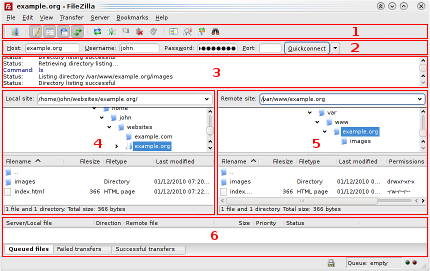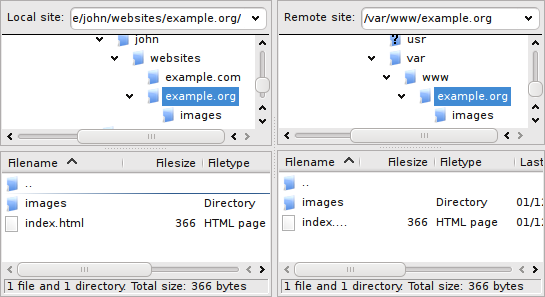How To Use Filezilla To Download Files
This tutorial in other languages: English (English language), Deutsch (High german), Español (Castilian), Français (French)
Note to editors: Please read this note on the tutorial scope before making additions.
Introduction
Welcome to the FileZilla Client tutorial. In this tutorial, you will learn how to
- Connect to an FTP server,
- Download and upload files,
- Use the site managing director.
If you already know how to use an FTP client, you may want to read the more advanced usage instructions instead.
Nosotros assume that you already installed and started FileZilla Client (installation instructions).
Connecting to a server
The showtime thing to do is connecting to a server.
This is our (fictional) login data - please use your own data instead if you want to actively follow the tutorial.
Hostname: example.org Username: john Countersign: 7PjU#.J3
Nosotros will use the quickconnect bar for establishing the connection:
![]()
Enter the hostname into the quickconnect bar'south Host: field, the username into the Username: field as well every bit the countersign into the Password: field. You may leave the Port: field empty unless your login information specifies a certain port to utilise. Now click on Quickconnect.
Note: If your login data specifies a protocol like SFTP or FTPS, enter the hostname as follows: sftp://hostname or ftps://hostname respectively.
FileZilla will now try to connect to the server. If all works well, you will notice that the correct "cavalcade" switched from Not connected to any server to displaying a list of files and directories.

Legend: 1. Toolbar, ii. Quick connect bar, 3. Message log, 4. Local pane, five. Remote pane, 6. Transfer queue (Full-size version)
The next step is to become familiar with FileZilla's window layout.
Here is a quick introduction: Below the toolbar (1) and quick connect bar (2), the bulletin log (iii) displays transfer and connection related messages. Beneath, you can find the file listings. The left cavalcade (local pane, 4) displays the local files and directories, i.e. the stuff on the PC you lot're using FileZilla on. The right cavalcade (server pane, five) displays the files and directories on the server yous are continued to. Both columns have a directory tree at the acme and a detailed listing of the currently selected directory'southward contents at the bottom. You tin easily navigate either of the trees and lists by clicking around like in whatever other file director. At the bottom of the window, the transfer queue (6) lists the to-exist-transferred and already transferred files.
Transferring files
Now we will upload these files (or the ones you choose, respectively):
website/ +- index.html +- images/ +- image01.jpg +- image02.jpg
Uploading
Outset - in the local pane - bring the directory into view which contains data to be uploaded (eastward.thousand. alphabetize.html and images/). At present, navigate to the desired target directory on the server (using the server pane's file listings). To upload the data, select the respective files/directories and drag them from the local to the remote pane. You will find that the files volition be added to the transfer queue at the bottom of the window and soon thereafter get removed again - since they were (hopefully, if nothing went incorrect) simply uploaded to the server. The uploaded files and directories should at present exist displayed in the server content listing at the right side of the window.

Local and remote file listings after uploading the instance files
Note: If you don't like using drag-and-drop, you can also right click on files/directories (in the lower local pane) and select Upload to upload them - or simply double-click a file entry (this does not work for directories).
Note (avant-garde): If you enable filtering and upload a complete directory, simply the not-filtered-out files and directories inside this directory volition be transferred.
Downloading
Downloading files, or complete directories, works essentially the same way every bit uploading - y'all just drag the files/directories from the remote pane to the local pane this fourth dimension, instead of the other mode round.
Note: In example you (accidentally) try to overwrite a file during upload or download, FileZilla will by default brandish a dialog request what to do (overwrite, rename, skip...).
Using the site manager
At present that y'all are confident in transferring files (if not, practice a fiddling bit), you might desire to add the server data to the site director to brand it easy to reconnect to this server. To do this, select Copy electric current connection to Site Director... in the File menu. The site manager will be opened and a new entry volition be created with all the important information already filled in. You lot volition notice that the entry'due south proper name is selected and highlighted - you can enter some descriptive proper noun so you volition later on detect your server again (enter something like domain.com FTP server for example - you tin rename it subsequently if you wish). Now close the dialog past clicking on OK.
The next time y'all want to connect to this server, you can but select it in the site manager and click Connect.
Conclusion
You should now be able to use the basic FileZilla features.
One terminal remark: Most tasks can exist completed in several ways. The ways chosen for this tutorial are the most clear ones - if y'all invest a bit of time and just await around or read some of the advanced documentation, yous will find much quicker means to achieve what you desire (there are toolbar buttons for often-used commands for instance; some besides react on right-clicking them).
If yous experience reasonably confident by at present, information technology might be worthwhile to too read the advanced usage instructions to learn about additional features not shown in this tutorial.
Further information
- Documentation: Documentation for the nigh important topics
- Site manager: Details most how to gear up upwards your sites in FileZilla
DOWNLOAD HERE
Posted by: jodiedonguarm.blogspot.com